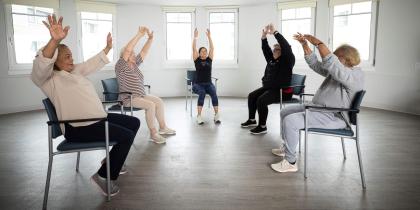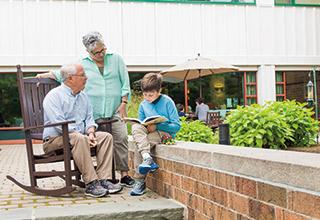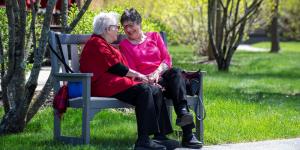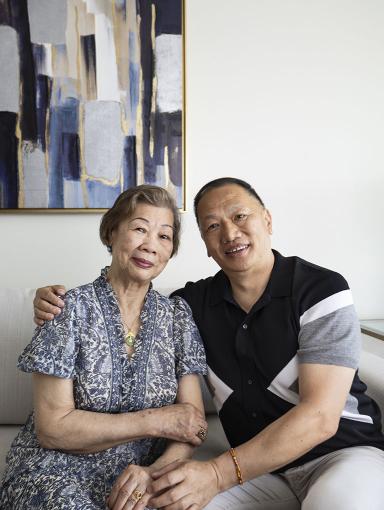Yoga for Seniors: How to Get Started at Any Age
A helpful guide to finding the right type of yoga for your unique needs.

Yoga is often recommended as a gentle and approachable way to move the body and calm the mind. While its research-supported benefits are well-established, discovering the best yoga practice for your needs can take some exploration — it’s not a one-size-fits-all situation.
As someone who lives with chronic pain, that’s a lesson I learned firsthand when I assumed that a “slow flow” yoga class would be gentle enough for me as a beginner with health challenges. After all, the word “slow” was right in the name! Instead, I struggled through the class and left in more pain than when I started.
As it turns out, even a slow flow was too quick for someone with my unique needs. Navigating the yoga world with considerations like chronic pain, mobility limitations, or natural changes that come with aging might feel frustrating or discouraging, but finding the right fit can lead to physical, emotional, and spiritual benefits.
The health benefits of yoga for seniors
While flexibility might be the first benefit that comes to mind when you think of yoga — and it’s a valuable one — there are plenty of other advantages to a regular practice. Rebecca Donato, a 200-hour registered yoga teacher and director of business and program development for Hebrew SeniorLife’s Right Care, Right Place, Right Time program, has practiced yoga for 20 years. She has “found that it can benefit you physically, mentally, and spiritually. Not everybody has to practice it at all those levels, but that’s the promise, benefit, and potential for yoga practice at all ages — and especially as we age,” she says.
Research supports yoga’s positive impacts on older adults’ physical and emotional well-being. One study found that yoga may offer neuroprotective benefits in women at risk for Alzheimer’s disease, potentially helping slow cognitive decline.
Another study linked yoga to psychological and physical benefits in older adults, including reduced anger, anxiety, fear of falling, and improved strength and balance. Additional studies have similarly found that yoga can increase mobility, balance, strength, and sleep.
For Rebecca, the spiritual benefits of yoga have become more profound in her life as she has grown older. “The mind and spirit can become even more important to us as we have a different relationship with our physical body. The real opportunity of yoga lies in how we can benefit from the mind, body, and spirit practice,” she adds.
Tips for safely starting yoga
You should consider a few things before starting a new yoga practice:
- Talk to your doctor if you have any health conditions. Check with your health care provider before starting yoga, especially if you have any medical conditions. Ask them what to be careful of and what you should tell your yoga instructor.
- Choose a studio that follows best practices. Your yoga instructor should introduce themselves to you, ask whether you have injuries, and be skilled at offering modifications. That might be more difficult in large classes, so finding the right setting is key.
- Seek out smaller classes. While a private yoga instructor offers the most personalized guidance, they can be expensive. Smaller classes are more affordable for receiving individual attention and adapting the practice to your needs.
- Communicate your concerns and needs. If you know you need accommodations or have questions about which class is the best fit, don’t hesitate to ask! Instructors and studio staff can offer recommendations on the best place to start.
“As you look for teachers and styles of yoga, it’s a bit like going shopping for clothing. You might have to do a little browsing to find what fits you well and what makes you feel good. If yoga isn’t making you feel calmed, settled, and better than when you left, it doesn’t mean yoga isn’t working for you. It might just mean the teacher or style isn’t quite right,” explains Rebecca.
Yoga styles that are supportive for older adults
Starting a new yoga practice can be exciting and overwhelming, especially when you’re facing many different styles. So, how do you know which type of yoga is best for you? According to Rebecca, these are some of the types of yoga that are often well-suited to the needs of older adults:
- Chair yoga uses a chair to adapt traditional yoga poses for those with mobility issues, injury, or balance concerns.
- Iyengar yoga focuses on precise alignment and uses props to support safe movements.
- Restorative yoga focuses on deeply relaxing poses supported by props and held for extended periods. It’s great for recovery and stress relief!
- Yin yoga uses long-held stretches targeting connective tissues and joints, improving flexibility and circulation.
- Yoga nidra is a form of guided meditation and deep relaxation, often called “yogic sleep.”
- Breathwork can calm the nervous system and center the mind, even if you aren’t ready for or cannot participate in physical activity.
Another option is yoga therapy, which differs from general yoga classes because it focuses on specific health challenges. “The yoga therapy world tries to help people who have particular conditions, like Parkinson’s disease, PTSD, and many types of chronic pain, by supporting them not only with physical postures, but also with other aspects of what yoga can do. It’s about working with breath, concentrating the mind, and asking yourself what better patterns you can choose to focus on,” explains Rebecca.
If you try a style of yoga that doesn’t feel right for your body, don’t give up. “Every flavor of yoga under the sun exists today, and where we are at a given time in our life might lead us to a certain kind of practice that will be most beneficial. That may or may not be our practice forever as our bodies change — it may need to evolve,” says Rebecca.
Getting the most out of your yoga practice
When you settle into a yoga class, your instructor may invite you to set an intention — a goal or focus for the practice. This simple step is a great reminder of your “why” — why did you choose to show up today?
“In anything we’re starting, especially if it’s related to our health, the more we know our ‘why,’ the easier the ‘how’ is. I’ve found that to be true in my own experience. Sometimes, an intention can be for someone else, if that person is actually what makes us more committed or willing to try something new,” says Rebecca.
Most yoga classes end with a savasana, a final pose of rest and stillness. While it may seem like the least active portion of the class, it can be the most meaningful portion for many people! “If your ‘why’ is for mind or spirit benefits, the savasana is the most important part of the class. When we lie in savasana, we take a few minutes to benefit from the nervous system being calm. We’re teaching the body to have some time to experience this,” says Rebecca.
Savasana can also bring clarity to your thoughts. “You may have a creative idea, a new perspective on something troubling you, or come to peace with something. It’s like dessert,” she adds. Even if you initially feel unsure about it, it’s worth exploring this restful moment to see whether it’s a piece of yoga that brings you value.
Staying active is easy at Hebrew SeniorLife
If you’re looking for a senior living community where staying active is simple and enjoyable, Hebrew SeniorLife may be the perfect fit. Our communities offer vibrant lifestyles and enriching amenities, including group exercise offerings such as yoga and a variety of wellness programs tailored to the needs of older adults.
Are you interested in exploring senior living options? Find a Hebrew SeniorLife community or service online to learn more.
Blog Topics
Learn More
Senior Living
Hebrew SeniorLife offers a variety of senior living options, including independent living, assisted living, and enhanced living. There are options for every lifestyle and budget.





